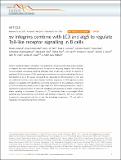αv Integrins combine with LC3 and atg5 to regulate Toll-like receptor signalling in B cells
Author(s)
Acharya, Mridu; Sokolovska, Anna; Tam, Jenny M.; Conway, Kara L.; Stefani, Caroline; Raso, Fiona; Mukhopadhyay, Subhankar; Feliu, Marianela; Paul, Elahna; Savill, John; Hynes, Richard O.; Xavier, Ramnik J.; Vyas, Jatin M.; Stuart, Lynda M.; Lacy-Hulbert, Adam; Hynes, Richard O.; ... Show more Show less
DownloadHynes_av integrins.pdf (2.431Mb)
PUBLISHER_CC
Publisher with Creative Commons License
Creative Commons Attribution
Terms of use
Metadata
Show full item recordAbstract
Integrin signalling triggers cytoskeletal rearrangements, including endocytosis and exocytosis of integrins and other membrane proteins. In addition to recycling integrins, this trafficking can also regulate intracellular signalling pathways. Here we describe a role for αv integrins in regulating Toll-like receptor (TLR) signalling by modulating intracellular trafficking. We show that deletion of αv or β3 causes increased B-cell responses to TLR stimulation in vitro, and αv-conditional knockout mice have elevated antibody responses to TLR-ligand-associated antigens. αv regulates TLR signalling by promoting recruitment of the autophagy component LC3 (microtubule-associated proteins 1 light chain 3) to TLR-containing endosomes, which is essential for progression from NF-κB to IRF signalling, and ultimately for traffic to lysosomes where signalling is terminated. Disruption of LC3 recruitment leads to prolonged NF-κB signalling and increased B-cell proliferation and antibody production. This work identifies a previously unrecognized role for αv and the autophagy components LC3 and atg5 in regulating TLR signalling and B-cell immunity.
Date issued
2016-05Department
Massachusetts Institute of Technology. Department of Biology; Koch Institute for Integrative Cancer Research at MITJournal
Nature Communications
Publisher
Nature Publishing Group
Citation
Acharya, Mridu et al. “Αv Integrins Combine with LC3 and atg5 to Regulate Toll-like Receptor Signalling in B Cells.” Nature Communications 7 (2016): 10917. © 2017 Macmillan Publishers Limited
Version: Final published version
ISSN
2041-1723